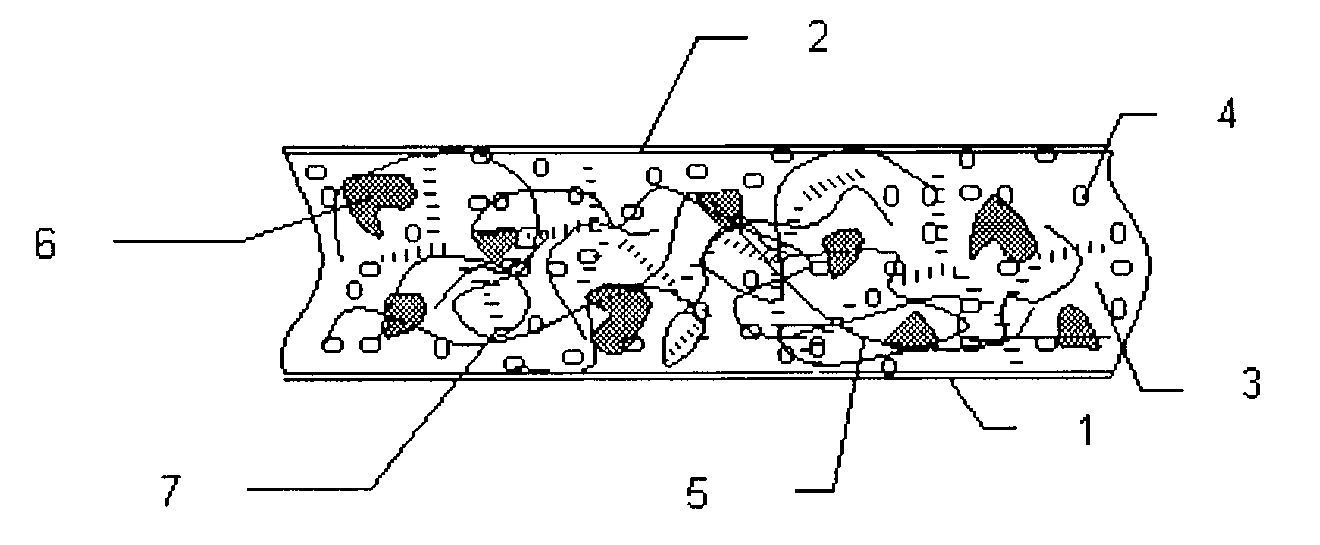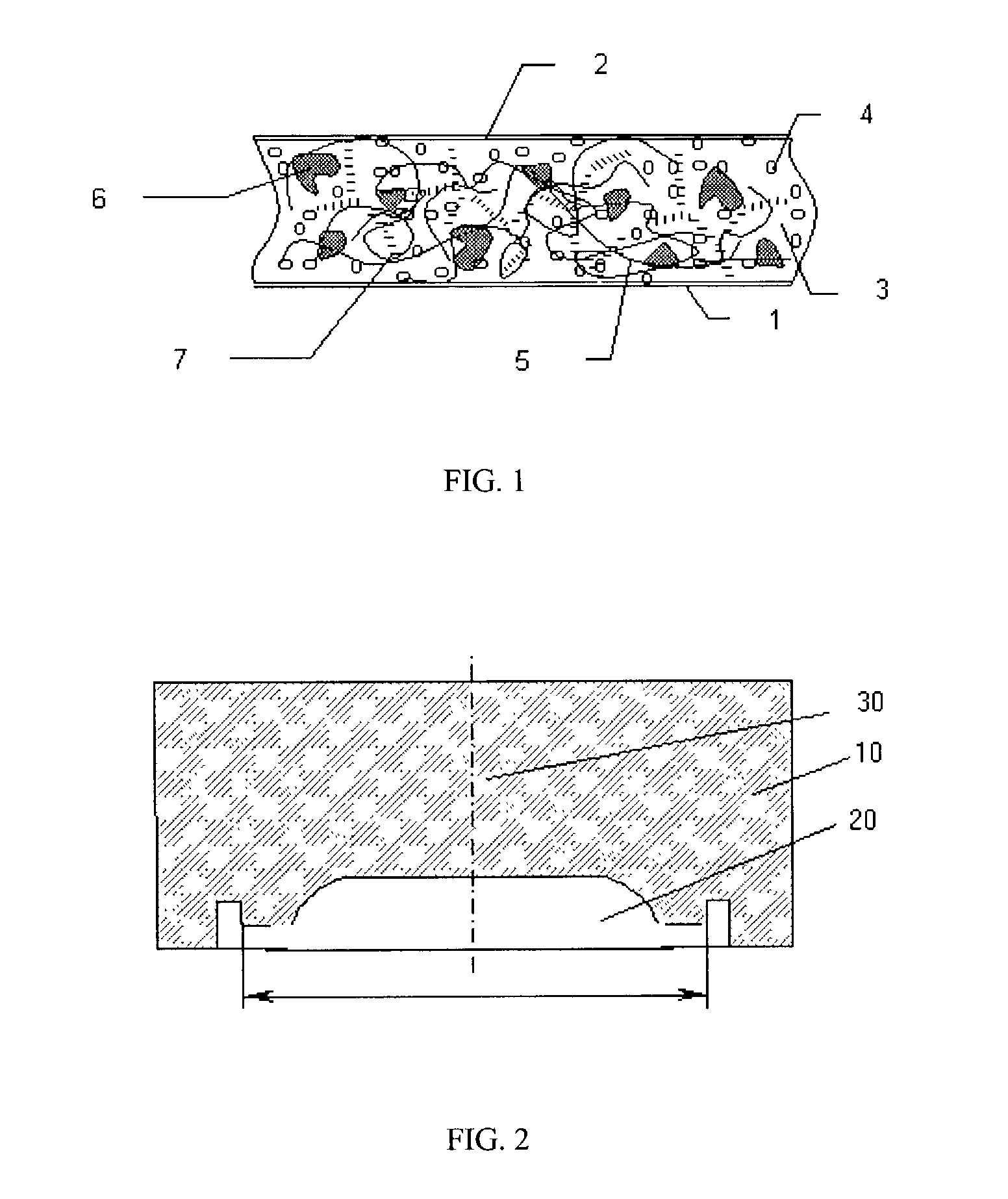Composition for cushions, wound dressings and other skin-contacting products
a technology of skin contact and composition, applied in the field of composition, can solve the problems of limited absorbance of wound dressings, wound injury upon removal, and use of adhesives,
- Summary
- Abstract
- Description
- Claims
- Application Information
AI Technical Summary
Benefits of technology
Problems solved by technology
Method used
Image
Examples
example 1
[0158]The following are exemplary formulations of skin-contacting adhesive of the invention. The prepared formulations were all translucent, as determined visually.
[0159]The manufacture of Formulations 1 and 2 involved adding the cellulose derived polymers at a high temperature (>130° C.). In this manner, the polymers are melted, forming liquid crystalline droplets, which are stretched at mixing giving fibers (high MW cellulose derived polymer) or ellipsoids (low MW cellulose derived polymer).
[0160]
IngredientWt %Formulation 1Hydrophobic polymer: Vector 411144.69Elastomeric plasticizer: Styrene plasticizer28.86Tackifying resin: Regalite ® 91001.86High MW Cellulose derived polymer: MF9.31Low MW Cellulose derived polymer: LF9.31Clay particles: Cloisite Na+5.6Other ingredients: Irganox ® 10100.37Formulation 2Hydrophobic polymer: Vector 411145.11Elastomeric plasticizer: Styrene plasticizer30.07Tackifying resin: Regalite ® 91001.88High MW Cellulose derived polymer: MF9.40Low MW Cellulose ...
example 2
[0167]The following is another exemplary formulation of the skin-contacting adhesive of the invention. The prepared formulation was translucent, as determined visually.
[0168]The manufacture of Formulation 3 involved adding the cellulose derived polymers at a lower temperature (about 100° C). In this manner, the polymers behaved like a powder.
[0169]
Formulation 3IngredientWt %Hydrophobic polymer: Vector 411145.54Elastomeric plasticizer: Styrene plasticizer29.41Tackifying resin: Regalite ® 91001.9High MW Cellulose derived polymer: MF9.49Low MW Cellulose derived polymer: LF9.49Clay particles: Cloisite Na+3.8Other ingredients: Irganox ® 10100.38
Water Uptake Studies
[0170]A water uptake study of Formulation 3 was conducted as described in Example 1. The percentage water uptake was 35.6, with a swell ratio of 1.22
Tack Studies
[0171]A tack study was conducted as described in Example 1. Formulation 3 had a tack of 375.7 g at 0.2 cm / sec and 142.3 g at 0.01 cm / sec.
example 3
[0172]The following is an additional exemplary formulation of the skin-contacting adhesive of the invention. The prepared formulation was translucent, as determined visually.
[0173]The manufacture of Formulation 4 involved adding the cellulose derived polymers at a high temperature (above 130° C.) so the polymers behaved like liquid crystals.
[0174]
Formulation 4IngredientWt % (temp / rpm)Tackifying resin: Regalite ® 910027.97(94 / 23)Hydrophobic polymer: Vector 41119.57(100 / 23)Hydrophobic polymer: Vector 41149.54(101 / 23)Elastomeric plasticizer: Styrene plasticizer14.5(151 / 31)Other: Adhesive Agent1.5(150 / 58)Clay particles: Cloisite Na+3.0(144 / 100)Low MW Cellulose derived polymer: JF11.97(140 / 100)High MW Cellulose derived polymer: GF17.95(144 / 100)High MW Cellulose derived polymer: HF4.0(146 / 100)
[0175]The ingredients are listed in the order in which they were added to the mixture. “Temp” refers to the temperature (° C.) of the mixture or melt when the particular ingredient was added, while “...
PUM
| Property | Measurement | Unit |
|---|---|---|
| wt % | aaaaa | aaaaa |
| wt % | aaaaa | aaaaa |
| wt % | aaaaa | aaaaa |
Abstract
Description
Claims
Application Information
 Login to View More
Login to View More - R&D
- Intellectual Property
- Life Sciences
- Materials
- Tech Scout
- Unparalleled Data Quality
- Higher Quality Content
- 60% Fewer Hallucinations
Browse by: Latest US Patents, China's latest patents, Technical Efficacy Thesaurus, Application Domain, Technology Topic, Popular Technical Reports.
© 2025 PatSnap. All rights reserved.Legal|Privacy policy|Modern Slavery Act Transparency Statement|Sitemap|About US| Contact US: help@patsnap.com



